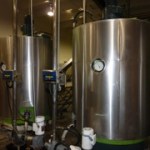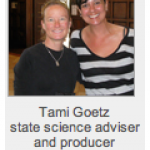biotechnology
Theo chocolate is situated in a neighborhood called Fremont, in the city of Seattle, in the former Redhook brewery. I used to consult for Redhook in my microbiology days, when I had access to a -80°C freezer and a proper microscope, so the building has a comfortable feel and some pleasant memories.
These days the bar is gone and the aromas are more like roasting coffee than brewing beer. Most of machinery, though, is surprisingly similar. The equipment is very much the same as the equipment you'd find in many kinds of biotech manufacturing facilities. There are giant scales, fermenters,…
Last summer, I had the good fortune to attend a conference in Washington D.C. on Vision and Change in Undergraduate Biology education. There were lots of inspiring speeches, cool videos, and talks about building more student-centered classrooms and strategies for change.
Surprisingly, many of the attendees seemed unaware that there is a group of instructors, and educational programs who embody this vision, albeit with a bit of twist.
These are the biotech instructors and biotech education programs at the community colleges.
Many of the ideas described at the Vision and Change conference…
Every June, an incredible event takes place.
Biotechnology educators gather in Berkeley, California, from across the US, to discuss new trends in biotechnology education, learn from each other and share information about educating students for the biotechnology workforce.
There are tours of local biotech companies like Genentech and local research institutes like the cancer center at UCSF. New kits and techniques can be tried and practiced in hands-on workshops. And instructors get to practice new bioinformatics techniques like analyzing Next Generation DNA sequencing data or working with…
As I wrote on Twitter yesterday, I am sending hugs, salutes, and immense respect to Dr. Chris Gunter and her colleagues at HudsonAlpha Institute for Biotechnology in Huntsville, Alabama.
Gunter, a self-described "recovering Nature editor" who serves as Director of Research Affairs at HudsonAlpha, is working with several of her colleagues at the institute to finish teaching an undergraduate neuroscience course that was left without a professor following the UAHuntsville tragedy.
Practical things first: Chris has sent out a call to any educators out there who have syllabi or slides for…
In a Japanese laboratory, a group of scientists is encouraging a rapidly expanding amoeba-like blob to consume Tokyo. Thankfully, the blob in question is a "slime mould" just around 20cm wide, and "Tokyo" is represented by a series of oat flakes dotted about a large plastic dish. It's all part of a study on better network design through biological principles. Despite growing of its own accord with no plan in mind, the mould has rapidly produced a web of slimy tubes that look a lot like Tokyo's actual railway network.
The point of this simulation isn't to reconstruct the monster attacks of…
While the coffee wasn't quite ready this morning, I ventured to the Wall Street Journal health page at the Wall Street Journal, one of my frequent first-reads.
I was immediately intrigued by a short article from the excellent Jennifer Corbett Dooren about Roche-Genentech gaining US FDA approval for a new rheumatoid arthritis drug, Actemra.
Actemra (tocilizumab) is a monoclonal antibody that works via a novel mechanism of blocking the receptor for interleukin-6, a pro-inflammatory molecule called a cytokine. What is most important is that Actemra appears to work in patients who have not been…
This morning I attended the Fifth Annual WBBA Governor's Life Sciences Summit. The breakfast was great; the talks were okay.
I do enjoy the stories about people who's lives were saved because of biotechnology and I agree that the focus of the summit, research and discovery are important, but I can't help thinking about the missing piece.
For the past ten years, I've been involved in a national experiment to help build an educated workforce for biotechnology. Through that time, I've learned about one glaring area where Washington state is missing out.
There's one word for the missing…
This summer, I had the good fortune to attend three (or was it four?) conferences on science education. One of the most inspirational conferences was one on Vision and Change in Biology Education. This conference was co-sponsored by the National Science Foundation and the AAAS. It was a call to action for biology educators and many of the points and findings resonated deep in my bones.
Then, I read the press release from the AAAS.
And right there in the middle, I found this statement from the AAAS CEO, Alan Leshner.
Leshner said the goal of undergraduate education should be to give students…
Last spring, I gave my first hands-on workshop in working with Next Generation Sequencing data at the Eighth Annual UT-ORNL-KBRIN Bioinformatics Summit at Fall Creek Falls State Park in Tennessee. The proceedings from that conference are now on-line at BMC Bioinformatics and it's fun to look back and reflect on all that I learned at the conference and all that's happened since.
Figure 1. Fall Creek Falls State Park, TN
When the conference took place, Geospiza had only just released new versions of GeneSifter Analysis Edition that could do gene expression analysis with Next Gen data.
Who…
Liveblogging from the Hi-Tec conference
I'm currently at the Hi-Tec conference in Scottsdale, Arizona. (If you follow me on Twitter - www.twitter.com/@digitalbio - you may have seen me complaining about the temperature). It's an interesting conference, so I'm going to share some of the things that I'm learning.
Dr. Travis Benanti and Dr. Steve Fonash from Penn State University are presenting an interesting session this morning on nanotechnology.
Luckily, you don't have to know anything about nanotechnology to find the session fascinating.
If you're interested in learning about nanotechnology…
For centuries, farmers have been genetically modifying their plants without even knowing it. That's the message from German scientists who found that grafting, a common technique used to fuse parts of two plants together, causes the two halves to swap genes with each other.
Grafting can involve fusing the stem of one plant (the scion) to the roots of another (the stock), or a dormant bud to another stem. There are many reasons for this - sometimes it's the most cost-effective way of cultivating the scion, sometimes the stock has properties that the scion lacks including hardiness or…
We had a great discussion in the comments yesterday after I published my NJ trees from some of the flu sequences.
If I list all the wonderful pieces of advice that readers shared, I wouldn't have any time to do the searches, but there are a few that I want to mention before getting down to work and posting my BLAST results.
Here were some of the great suggestions and pieces of advice;
1. Do a BLAST search. Right! I can't believe I didn't do that first thing, I think the trees I got surprised me so much all sense flew out of my brain.
2. Show us the multiple alignments. Okay. I'll…
This is a video that a friend made that shows, very clearly, how to pour an agarose gel, load the samples and run it. I especially like the way he used a bit of time lapse photography to show the dyes separating as the gel ran.
A large study weighs up the existing evidence on the impact of GM crops on local insect life, providing some much-needed scientific rigour to the GM debate.
In Europe, the 'GM debate' about the merits and dangers of genetically-modified (GM) crops is a particularly heated one. There is a sense of unease about the power of modern genetic technology, and a gut feeling that scientists are 'playing God'. These discontents are stoked by the anti-GM camp, who describe GM crops with laden and fear-mongering bits of unspeak like 'Frankenstein foods' and 'unnatural'.
In a debate so fuelled by…
A long-sought goal in genetics has been to develop therapies that can use correctly functioning genes to replace genes with defects. If we had the technology to predictably modify our genomes, we would have the ability to cure many diseases instead of having to place people on medications for their entire lives.
For a long time, gene therapy has remained an elusive dream. But, in the past few years the dream has come closer to reality, especially in the case of ten children, who live because of researchers who kept that dream in sight (1).
Figure 1. Random children
Technorati Tags:…
The HudsonAlpha Institute for Biotechnology is a non-profit organization that opened it's doors in April, 2008. One of the great things about this institute is it's commitment to sharing biotech knowledge with the surrounding community.
For the general public, HudsonAlpha has a ongoing written series on biology topics called Biotech 101. Teachers will probably find this useful too. There's a great description of Copy Number Variation written by Dr. Neil Lamb, their director of educational outreach. Some of the other pieces discuss Microarrays, Epigenetics, and RNAi.
School programs…
I don't know if any DIY biologists are looking for projects, but I think engineering yeast with a gene to detect heavy metals might be a good DIY biology project and I have some ideas for how to do this.
What are the advantages of using yeast and working on this kind of problem?
This could have a socially beneficial result. Contamination of soils, water, and even toys with heavy metals like lead, arsenic, and others, is a growing problem. If DIY biologists could make a cheap test, it could be helpful for a large number of people.
Yeast, at least the ones I'm thinking about, Saccharomyces…
Some of the things that are attracting people to DIY biology are:
the idea of doing science with others for fun
the possibility of doing something that might be beneficial to society
being part of larger movement
All of those notions appeal to me and since I've been involved with biotech for many years, I have lots of project ideas. After thinking about the yogurt and melamine detection project, I started to wonder if a DIY project could even have a bigger impact, and say, develop a cheap test for heavy metals like arsenic or lead.
In Seattle, it costs between $30 and $50 to test water…
My oldest daughter's favorite sweatshirt is one from the Seattle Children's Theatre Drama School, with the motto, "What's your motivation?"
I was reminded of motivation the other day, as I talked about projects with the DIY biology group. It's pretty clear that you can't pick a project without knowing whether you're motivated by the discovery or the application.
Many of the people I've known in academia, either researchers or science educators, are motivated by the prospect of discovery. They either want to discover something new or help their students make discoveries. Inquiry-based…
This afternoon, I attended the first meeting of a DIY biology group in Seattle, after a kind invitation from one of the founders.
DIY, for those of you new to the acronym, stands for "Do It Yourself."
But, you say, there are lots of people who do biology on their own. Some people keep pets. Some have children. Others raise tropical fish, go bird watching, or mushroom hunting. Some people even make yogurt or cheese, or brew beer, or make wine. What makes DIY biology so different?
This isn't your grandfather's home brew
Well, lets say for now that it's a little…



